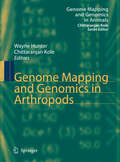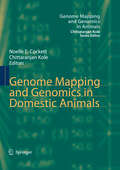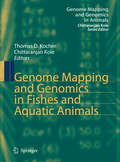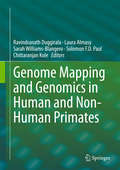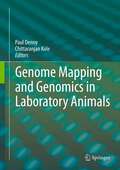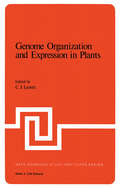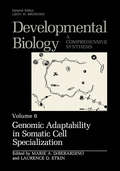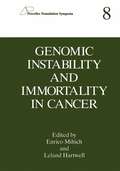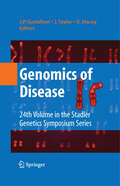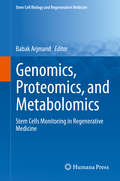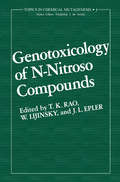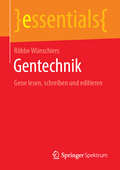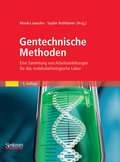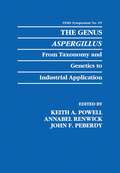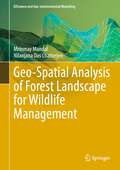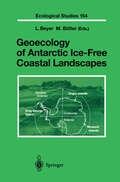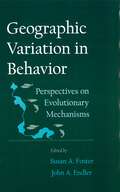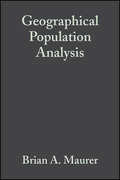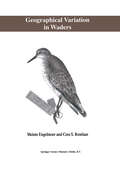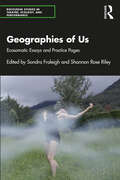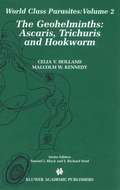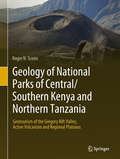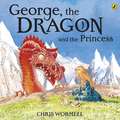- Table View
- List View
Genome Mapping and Genomics in Arthropods (Genome Mapping and Genomics in Animals #1)
by Wayne Hunter Chittaranjan KoleThe series "Genome Mapping and Genomics in Animals" provides comprehensive and up-to-date reviews on genomic research on a large variety of selected animal systems, contributed by leading scientists from around the world. The huge amount of information hitherto dispersed in journals is now available in this clearly structured reference work. Arthropods covered here include honeybee, bumblebee, the parasitic Jewel Wasp, silkworm, pea aphid, mosquito, Hessian fly and tick.
Genome Mapping and Genomics in Domestic Animals (Genome Mapping and Genomics in Animals #3)
by Noelle E. Cockett Chittaranjan KoleGenomics research on animals has generated huge databases and several new concepts and strategies, which are used to elucidate origin, evolution and phylogeny of species. Genetic and physical maps of genomes give details on chromosomal location, function, expression and regulation of genes. The series Genome Mapping and Genomics in Animals provides comprehensive and up-to-date reviews on genomic research on selected animal systems contributed by leading scientists from around the world. This volume offers information on gene mapping and genomics research in domesticated and farmed animals including cattle, water buffalo, sheep, deer, poultry, turkeys, rabbits, dogs and pigs. While the genome maps for some species are very limited, full genome sequences are available for cattle, chickens and dogs. Genomic research contributes to the identification of genetic regions that control the functionality and well-being of animals. Several farmed species are also used as models for biomedical studies.
Genome Mapping and Genomics in Fishes and Aquatic Animals (Genome Mapping and Genomics in Animals #2)
by Thomas D. Kocher Chittaranjan KoleMapping of animal genomes has generated huge databases and several new concepts and strategies, which are useful to elucidate origin, evolution and phylogeny. Genetic and physical maps of genomes further provide precise details on chromosomal location, function, expression and regulation of academically and economically important genes. The series Genome Mapping and Genomics in Animals provides comprehensive and up-to-date reviews on genomic research on a large variety of selected animal systems, contributed by leading scientists from around the world. This volume summarizes the first era of genomic studies of aquaculture species, in which the tools and resources necessary to support whole-genome sequencing were developed. These tools will enhance efforts toward selective breeding of aquaculture species. Included in this volume are summaries of work on salmonids, cyprinids, catfish, tilapias, European sea bass, Japanese flounder, shrimps and oysters.
Genome Mapping and Genomics in Human and Non-Human Primates (Genome Mapping and Genomics in Animals #5)
by Ravindranath Duggirala Laura Almasy Sarah Williams-Blangero Solomon F.D. Paul Chittaranjan KoleThis book provides an introduction to the latest gene mapping techniques and their applications in biomedical research and evolutionary biology. It especially highlights the advances made in large-scale genomic sequencing. Results of studies that illustrate how the new approaches have improved our understanding of the genetic basis of complex phenotypes including multifactorial diseases (e.g., cardiovascular disease, type 2 diabetes, and obesity), anatomic characteristics (e.g., the craniofacial complex), and neurological and behavioral phenotypes (e.g., human brain structure and nonhuman primate behavior) are presented.Topics covered include linkage and association methods, gene expression, copy number variation, next-generation sequencing, comparative genomics, population structure, and a discussion of the Human Genome Project. Further included are discussions of the use of statistical genetic and genetic epidemiologic techniques to decipher the genetic architecture of normal and disease-related complex phenotypes using data from both humans and non-human primates.
Genome Mapping and Genomics in Laboratory Animals (Genome Mapping and Genomics in Animals #4)
by Paul Denny and Chittaranjan KoleMapping of animal genomes has generated huge databases and several new concepts and strategies, which are useful to elucidate origin, evolution and phylogeny. Genetic and physical maps of genomes further provide precise details on chromosomal location, function, expression and regulation of academically and economically important genes. The series Genome Mapping and Genomics in Animals provides comprehensive and up-to-date reviews on genomic research on a large variety of selected animal systems, contributed by leading scientists from around the world.Laboratory animals are those species that by accident of evolution, domestication and selective breeding are amenable to maintenance and study in a laboratory environment. Many of these species are studied as 'models' for the biology and pathology of humans. Laboratory animals included in this volume are sea-urchin, nematode worm, fruit fly, sea squirts, puffer fishes, medaka fish, African clawed frog, mouse and rat.
Genome Organization and Expression in Plants (Nato ASI Subseries A: #29)
by C. LeaverIn the summer of 1976 a successful workshop on nucleic acids and protein synthesis in plant systems was organised in Strasbourg by Jacques Weil and Lawrence Bogorad. The participants in the workshop, were, without exception, excited both by the quality of the work discussed and by the rapid progress being made in several areas of genomic analysis and expression in plants. It also became apparent that there was a need for an international assembly of this sort at regular intervals. These workshops not only encourage stim ulating discussion and constructive thinking but also result in increased collaboration and productive liaison between laboratories with common interests. Hence a ten-day advanced studies institute course was organised in Edinburgh from 11-21 July 1979, and in this volume we have published the contributions given by the invited speakers. The subjects discussed covered most areas of plant molecular biology and the lecturers were asked to balance a review of their chosen subject with the results of their own recent research and likely future advances. Probably the most important technical advance since the previous meeting of this group in Strasbourg, was the application of restriction enzyme analysis and cloning techniques. This is illustrated in many of the published lectures and was the basis for many of the more informal discussion sessions.
Genomic Adaptability in Somatic Cell Specialization: Genomic Adaptability In Somatic Cell Specialization (Developmental Biology #6)
by Marie A. DiBerardino Laurence D. EtkinI am pleased to include this book as Volume 6 of Developmental Biology: A Comprehensive Synthesis. It has been edited by two of the foremost investiga tors in the study of genomic adaptability. lowe a special debt of gratitude to Dr. Marie A. DiBerardino, who developed the concept of the volume. Dr. DiBerar dino is also a very active member of the editorial board for this series. Much of the success of this series is due to her valuable advice. This series was established to create comprehensive treatises on specific topics in developmental biology. Such volumes serve a useful role in develop mental biology, since it is a very diverse field that receives contributions from a wide variety of disciplines. This series is a meeting ground for the various practitioners of this science, facilitating an integration of heterogeneous infor mation on specific topics. Each volume is intended to provide the conceptual basis for a comprehen sive understanding of its topic as well as analysis of the key experiments upon which that understanding is based. The specialist in any aspect of developmen tal biology should understand the experimental background of the field and be able to place that body of information in context to ascertain where additional research would be fruitful. At that point, the creative process generates new experiments. This series is intended to be a vital link in that process of learning and discovery.
Genomic Instability and Immortality in Cancer (Pezcoller Foundation Symposia #8)
by LelandHartwell EnricoMihichProceedings of the Eighth Annual Pezcoller Symposium held in Trento, Italy, June 17-19, 1996
Genomics of Disease (Stadler Genetics Symposia Series)
by J. P. Gustafson J. Tayler G. StaceyThis title develops from the 24th Stadler symposium. It explores the general theme "GENOME EXPLOITATION: Data Mining the Genomes". The idea behind the theme is to discuss and illustrate how scientists are going to characterize and make use of the massive amount of information being accumulated about plant and animal genomes. The book presents a state-of-the-art picture on mining the Genome databases. Its chapters are authored by key stars in the field.
Genomics, Proteomics, and Metabolomics: Stem Cells Monitoring in Regenerative Medicine (Stem Cell Biology and Regenerative Medicine)
by Babak ArjmandThis book provides thorough coverage of high-throughput OMICs technologies for the monitoring of stem cells and regenerative medicine. Specific topics covered include the genomics, proteomics, and metabolomics aspects of regenerative medicine, metabolic profiling of mesenchymal stem cells, genome profiling of mesenchymal stem cells, OMICs monitoring of stem cell-derived exosomes, stem cell proteomics, lipidomics, OMICs profiling of cancer (stem) cells, and finally ethical considerations of OMICs-based investigations. Chapters are authored by world-renowned scientists who have valuable expertise in the field of OMICs and regenerative medicine.Genomics, Proteomics, and Metabolomics: Stem Cells Monitoring in Regenerative Medicine, part of Springer’s Stem Cell Biology and Regenerative Medicine series, is essential reading for researchers, clinicians, biologists, biochemists, and pharmaceutical experts conducting research in the fields of stem cell biology, molecular aspects of stem cell research, tissue engineering, regenerative medicine, cellular therapy, OMICs, bioinformatics, and ethics.
Genotoxicology of N-Nitroso Compounds (Topics in Chemical Mutagenesis)
by T. RaoToph's in Chemical Mutagenesis is a new series dedicated to studies in the areas of environmental chemical mutagenesis and genetic toxicology. In this series we will explore some of many topics that are emerging in these rapidly developing fields. The purpose of the present volume is to attempt to organize and compare the genotoxic properties of the N-nitroso compounds. This is a particularly interesting class of compounds because of the problems encountered with the Salmonella assay of Ames in generating both false positive and false negative results. The battery approach using a number of assay systems seems more appropriate to evaluate chemicals in this class. Topics to be discussed in other volumes in this series include single-cell mutation monitoring systems, the detection of genetic damage in mammalian germ cells, the mutagenicity of pesticides, problems in monitoring human populations in genetic toxicology, and a glossary of terms in genetic toxicology. All of these books are in various stages of development and should appear within the next few years. Frederick J. de Serres Series Editor vii Preface During the past ten years there has been an explosive development in the number of short-term tests to predict the biological risks, especially risks of cancer, in exposure to xenobiotic chemicals. The number of published articles in this area has reached many thousands a year and there are several new journals devoted almost entirely to the presentation of the results obtained in these tests.
Gentechnik: Gene lesen, schreiben und editieren (essentials)
by Röbbe WünschiersDieses essential soll als Einführung für eine zeitgemäße öffentliche Diskussion zur Gentechnologie dienen. Die Gentechnik betrifft uns alle in vielen Bereichen und wir müssen uns trauen, bunter und weiter zu denken. Tatsächlich kann bereits das komplette Erbgut von Viren und Bakterien chemisch erzeugt und „zum Leben erweckt“ werden. Mit der Genchirurgie ist die Medizin an einem Scheidepunkt: Wollen wir Erbkrankheiten therapieren oder genetisch „reparieren“? Und die Analyse tausender menschlicher Erbgute fördert Informationen zutage, die mit komplexen Krankheiten, aber auch Merkmalen wie Intelligenz in Verbindung stehen. Wie sollen wir dieses Wissen nutzen? Es stellt sich kaum noch die Frage, ob wir Gentechnik wollen, sondern vielmehr, wie wir sie anwenden.
Gentechnische Methoden: Eine Sammlung von Arbeitsanleitungen für das molekularbiologische Labor
by Monika Jansohn Sophie RothhämelIn der 5. Auflage dieses bewährten Laborhandbuches werden molekularbiologische Methoden in Form von reproduzierbaren Arbeitsvorschriften präsentiert. Es richtet sich an Studierende der Biowissenschaften und an Technische Assistenten im medizintechnischen Labor , die neue Methoden etablieren wollen, sowie an erfahrene Wissenschaftler zum schnellen Nachschlagen. Besonderer Wert wurde auf Sicherheitshinweise und das Aufzeigen von Fehlerquellen gelegt. Damit ist dieses Buch wiederum ein unverzichtbares Hilfsmittel für jedes molekularbiologische Labor.
The Genus Aspergillus: From Taxonomy and Genetics to Industrial Application (F.E.M.S. Symposium Series #69)
by Keith A. Powell Annabel Renwick John F. PeberdyProceedings of a symposium held in Canterbury, United Kingdom, April 5-8, 1993.
Geo-Spatial Analysis of Forest Landscape for Wildlife Management (GIScience and Geo-environmental Modelling)
by Mrinmay Mandal Nilanjana Das ChatterjeeThis book presents research on landscape ecology and the relationship between humans and wildlife. It helps readers understand how ecological patterns and processes are interconnected. This research illustrates and proposes (practicable) management strategies toward long-term ecological restoration and mitigation of consequences of conflict. Increasing wildlife activities in localities and forest fringes are an alarming issue. Ecological processes like movement, colonization, extinction and conflict issues depend on the landscape and ecological activities, the movement for example of migratory elephants and their colonization not only affects society but the wildlife and biodiversity too. Strategic management measures can contribute to enriching the biodiversity, habitat quality as well as landscape, while minimizing human-wildlife conflicts. This book describes landscape ecological patterns and processes, habitat dominancy, habitat dependency, suitability, connectivity and corridor selection. To synthesize these patterns and processes, several ecological indices are used. Use of geo-spatial techniques improves future management strategies for similar circumstances, especially, related to forest regeneration and forest restoration. This book provides a concise overview to a wide range of readers including postgraduate students, researcher, academics, landscape planners, decision makers and even local populations. The techniques and management strategies described should help planners to improve forest management, by implementing quality enhancement programs such as plantation area selection and corridor selection.
Geoecology of Antarctic Ice-Free Coastal Landscapes (Ecological Studies #154)
by L Beyer M. BölterResearch in Antarctica in the past two decades has fundamentally changed our perceptions of the southern continent. This volume describes typical terrestrial environments of the maritime and continental Antarctic. Life and chemical processes are restricted to small ranges of ambient temperature, availability of water and nutrients. This is reflected not only in life processes, but also in those of weathering and pedogenesis. The volume focuses on interactions between plants, animals and soils. It includes aspects of climate change, soil development and biology, as well as above- and below-ground results of interdisciplinary research projects combining data from botany, zoology, microbiology, pedology, and soil ecology.
Geographic Variation In Behavior: Perspectives On Evolutionary Mechanisms
by Susan A. Foster John A. EndlerGeographic Variation in Behavior: Perspectives on Evolutionary Mechanisms
by Susan A. Foster John A. EndlerStudies of animal behavior often assume that all members of a species exhibit the same behavior. Geographic Variation in Behavior shows that, on the contrary, there is substantional variation within species across a wide range of taxa. Including work from pioneers in the field, this volume provides a balanced overview of research on behavioral characteristics that vary geographically. The authors explore the mechanisms by which behavioral differences evolve and examine related methodological issues. Taken together, the work collected here demonstrates that genetically based geographic variation may be far more widespread than previously suspected. The book also shows how variation in behavior can illuminate both behavioral evolution and general evolutionary patterns. Unique among books on behavior in its emphasis on geographic variation, this volume is a valuable new resource for students and researchers in animal behavior and evolutionary biology.
Geographical Population Analysis: Tools for the Analysis of Biodiversity
by Brian A. MaurerConservation biology -- using concepts from traditional resource management and modern population biology to preserve biological diversity -- has emerged as one of the most important areas of ecology In order to really understand the problems of decreasing diversity and the solutions to maintaining it, the attention of ecologists must be focused on larger spatial and temporal scales than they are used to. The book discusses methods and statistical techniques that can be used to analyze spatial patterns in geographic populations. These techniques incorporate ideas from fractal geometry to develop measures of geographic range fragmentation, and can be used to ask questions regarding the conservation of biodiversity.
Geographical Variation in Waders
by M. Engelmoer C.S. RoselaarMorphometrical differentiation 63 Prediction of breeding origin . . . . . . . . . . . . . . . . . . . . . . . . . . . . . . . . . . . . . . . . . . . . . . . . . 68 Body mass 69 Primary moult 69 Discussion . . . . . . . . . . . . . . . . . . . . . . . . . . . . . . . . . . . . . . . . . . . . . . . . . . . . . . . . . . . . . . . 69 The taxonomy of the Eurasian Golden Plover 69 The existence of a partial breast-feather moult during breeding 69 Morphometrical differentiation between both sexes . . . . . . . . . . . . . . . . . . . . . . . . 70 The occurrence of primary moult on the breeding grounds 70 Summary 70 6 Grey Plover - Pluvialis squatarola 71 Introduction . . . . . . . . . . . . . . . . . . . . . . . . . . . . . . . . . . . . . . . . . . . . . . . . . . . . . . . . . . . . . . 73 Morphometrical differentiation 77 Prediction of breeding origin . . . . . . . . . . . . . . . . . . . . . . . . . . . . . . . . . . . . . . . . . . . . . . . . . 80 Accuracy 81 Exclusivity 81 Contact zones . . . . . . . . . . . . . . . . . . . . . . . . . . . . . . . . . . . . . . . . . . . . . . . . . . . . . . . . . . . . 82 Body mass 85 Primary moult 85 Discussion . . . . . . . . . . . . . . . . . . . . . . . . . . . . . . . . . . . . . . . . . . . . . . . . . . . . . . . . . . . . . . . 86 The taxonomy of the Grey Plover . . . . . . . . . . . . . . . . . . . . . . . . . . . . . . . . . . . . . . 86 Small size at northern latitudes . . . . . . . . . . . . . . . . . . . . . . . . . . . . . . . . . . . . . . . . 87 Morphometrical variation in the Palearctic 87 Summary 87 7 Red Knot - Calidris canutus . . . . . . . . . . . . . . . . . . . . . . . . . . . . . . . . . . . . . . . . . . . . . 89 Introduction . . . . . . . . . . . . . . . . . . . . . . . . . . . . . . . . . . . . . . . . . . . . . . . . . . . . . . . . . . . . . . 91 Morphometrical differentiation 93 Prediction of breeding origin . . . . . . . . . . . . . . . . . . . . . . . . . . . . . . . . . . . . . . . . . . . . . . . . . 99 Accuracy 99 Exclusivity 101 Contact zones . . . . . . . . . . . . . . . . . . . . . . . . . . . . . . . . . . . . . . . . . . . . . . . . . . . . . . . . . . . 102 Body mass 102 Primary moult 103 Discussion . . . . . . . . . . . . . . . . . . . . . . . . . . . . . . . . . . . . . . . . . . . . . . . . . . . . . . . . . . . . . . 103 of the Knot . . . . . . . . . . . . . . . . . . . . . . . . . . . . . . . . . . . . . . . . . . . 103 The taxonomy Is the knot breeding in Yakutia? 106 Different degrees of geographical variation in the d'd' and !f!f 106 Summary . . . . . . . . . . . . . . . . . . . . . . . . . . . . . . . . . . . . . . . . . . . . . . . . . . . . . . . . . . . . . . . 107 8 Sanderling - Calidris alba 109 Introduction . . . . . . . . . . . . . . . . . . . . . . . . . . . . . . . . . . . . . . . . . . . . . . . . . . . . . . . . . . . . . 111 Morphometrical differentiation 111 Prediction of breeding origin . . . . . . . . . . . . . . . . . . . . . . . . . . . . . . . . . . . . . . . . . . . . . . . . 116 Accuracy 116 Exclusivity 118 Contact zones . . . . . . . . . . . . . . . . . . . . . . . . . . . . . . . . . . . . . . . . . . . . . . . . . . . . . . . . . . . 118 Body mass 118 Primary moult 118 Discussion . . . . . . . . . . . . . . . . . . . . . . . . . . . . . . . . . . . . . . . . . . . . . . . . . . . . . . . . . . . . . . 118 The taxonomy of the Sanderling . . . . . . . . . . . . . . . . . . . . . . . . . . . . . . . . 118 Sexing Sanderlings 119 Summary . . . . . . . . . . . . . . . . . . . . . . . . . . . . . . . . . . . . . . . . . . . . . . . . . . . . . . . . . . . . . . . 119 VI 9 Curlew Sandpiper - Calidris ferruginea 121 Introduction . . . . . . . . . . . . . . . . . . . . . . . . . . . . . . . . . . . . . . . . . . . . . . . . . . . . . . . . . . . . . 123 Morphometrical differentiation 123 Prediction of a bird's sex . . . . . . . . . . . . . . . . . . . . . . . . . . . . . . . . . . . . . . . . 127 Accuracy 127 Exclusivity 127 Body mass 127 Primary moult 127 Discussion . . . . . . . . . . . . . . . . . . . . . . . . . . .
Geographies of Us: Ecosomatic Essays and Practice Pages (Routledge Studies in Theatre, Ecology, and Performance)
by Sondra Fraleigh Shannon Rose RileyGeographies of Us: Ecosomatic Essays and Practice Pages is the first edited collection in the field of ecosomatics.With a combination of essays and practice pages that provide a variety of scholarly, creative, and experience-based approaches for readers, the book brings together both established and emergent scholars and artists from many diverse backgrounds and covers work rooted in a dozen countries. The essays engage an array of crucial methodologies and critical/theoretical perspectives, including practice-based research in the arts, especially in performance and dance studies, critical theory, ecocriticism, Indigenous knowledges, material feminist critique, quantum field theory, and new phenomenologies. Practice pages are shorter chapters that provide readers a chance to engage creatively with the ideas presented across the collection. This book offers a multidisciplinary perspective that brings together work in performance as research, phenomenology, and dance/movement; this is one of its significant contributions to the area of ecosomatics.The book will be of interest to anyone curious about matters of embodiment, ecology, and the environment, especially artists and students of dance, performance, and somatic movement education who want to learn about ecosomatics and environmental activists who want to learn more about integrating creativity, the arts, and movement into their work.
Geographies of Us: Ecosomatic Essays and Practice Pages (Routledge Studies in Theatre, Ecology, and Performance)
Geographies of Us: Ecosomatic Essays and Practice Pages is the first edited collection in the field of ecosomatics.With a combination of essays and practice pages that provide a variety of scholarly, creative, and experience-based approaches for readers, the book brings together both established and emergent scholars and artists from many diverse backgrounds and covers work rooted in a dozen countries. The essays engage an array of crucial methodologies and critical/theoretical perspectives, including practice-based research in the arts, especially in performance and dance studies, critical theory, ecocriticism, Indigenous knowledges, material feminist critique, quantum field theory, and new phenomenologies. Practice pages are shorter chapters that provide readers a chance to engage creatively with the ideas presented across the collection. This book offers a multidisciplinary perspective that brings together work in performance as research, phenomenology, and dance/movement; this is one of its significant contributions to the area of ecosomatics.The book will be of interest to anyone curious about matters of embodiment, ecology, and the environment, especially artists and students of dance, performance, and somatic movement education who want to learn about ecosomatics and environmental activists who want to learn more about integrating creativity, the arts, and movement into their work.
The Geohelminths: Ascaris, Trichuris and Hookworm (World Class Parasites #2)
by Celia V. Holland Malcolm W. KennedyThe soil-transmitted nematode parasites, or geohelminths, are - called because they have a direct life cycle, which involves no intermediate hosts or vectors, and are transmitted by faecal contamination of soil, foodstuffs and water supplies. They all inhabit the intestine in their adult stages but most species also have tissue-migratoryjuvenile stages, so the disease manifestations they cause can therefore be both local and systemic. The geohelminths together present an enormous infection burden on humanity. Those which cause the most disease in humans are divided into three main groupings, Ascaris lumbricoides (the large roundworm), Trichuris trichiura (whipworm), and the blood-feeding hookworms (Ancylostoma duodenale and Necator americanus ), and this book concentrates on these. These intestinal parasites are highly prevalent worldwide, A. lumbricoides is estimated to infect 1471 million (over a quarter ofthe world’s population), hookworms 1277 million, and T. trichiura 1049 million. The highly pathogenic Strongyloides species might also be classified as geohelminths, but they are not dealt with here because the understanding of their epidemiology, immunology and genetics has not advanced as rapidly as for the others. This is primarily because of the often covert nature of the infections, with consequent difficulties for analysis. If there is ever a second edition of this book, then there will hopefully be much to say about this infection.
Geology of National Parks of Central/Southern Kenya and Northern Tanzania: Geotourism of the Gregory Rift Valley, Active Volcanism and Regional Plateaus
by Roger N. ScoonThis book describes the interrelationship between the spectacular geology of an area of East Africa that includes a branch of the rift valley, as well as giant freestanding ice-capped mountains and extraordinarily toxic, alkaline lakes, and some of the greatest concentrations of wildlife on Earth. It suggests that geological processes that have shaped the iconic landforms, including active volcanoes, may also be responsible for the unusually diverse speciation which characterises the region. Moreover, it is not a coincidence that important palaeoanthropological discoveries have been unearthed in the region. National parks and conservation areas have tremendous potential for geotourism and the book assists both tour guides and visitors in this regard. In addition, the book may provide a better understanding to management of the importance of geology for sustaining wildlife.
George, the Dragon and the Princess
by Christopher WormellFar, far away over the high, high mountains in an old castle wall, in a tiny, tiny hole there lives a little mouse called George. He's very small and rather timid and he can be a bit clumsy too. In fact, poor George is so hopeless that he can't even make lunch without burning his cheese on toast!But when a huge and terrifying dragon attacks the castle, George springs into action! Because as fans of George and the Dragon know only too well, George has a very special talent . . .This stunning new edition is perfect for new readers, as well as fans of George and the Dragon. This is a charming children's tale from the exceptional storyteller and illustrator, Chris Wormell.
